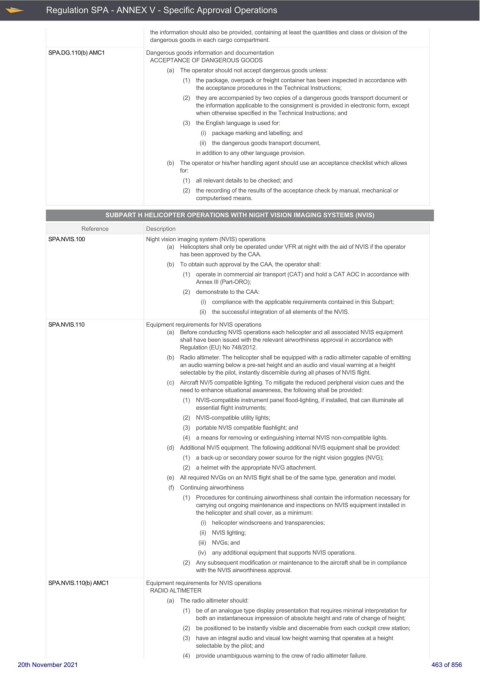Page 463 - UK Air Operations Regulations 201121
P. 463
~
~ Regulation SPA - ANNEX V - Specific Approval Operations Centrik
the information should also be provided, containing at least the quantities and class or division of the
dangerous goods in each cargo compartment.
SPA.DG.110(b) AMC1 Dangerous goods information and documentation
ACCEPTANCE OF DANGEROUS GOODS
(a) The operator should not accept dangerous goods unless:
(1) the package, overpack or freight container has been inspected in accordance with
the acceptance procedures in the Technical Instructions;
(2) they are accompanied by two copies of a dangerous goods transport document or
the information applicable to the consignment is provided in electronic form, except
when otherwise specified in the Technical Instructions; and
(3) the English language is used for:
(i) package marking and labelling; and
(ii) the dangerous goods transport document,
in addition to any other language provision.
(b) The operator or his/her handling agent should use an acceptance checklist which allows
for:
(1) all relevant details to be checked; and
(2) the recording of the results of the acceptance check by manual, mechanical or
computerised means.
SUBPART H HELICOPTER OPERATIONS WITH NIGHT VISION IMAGING SYSTEMS (NVIS)
Reference Description
SPA.NVIS.100 Night vision imaging system (NVIS) operations
(a) Helicopters shall only be operated under VFR at night with the aid of NVIS if the operator
has been approved by the CAA.
(b) To obtain such approval by the CAA, the operator shall:
(1) operate in commercial air transport (CAT) and hold a CAT AOC in accordance with
Annex III (Part-ORO);
(2) demonstrate to the CAA:
(i) compliance with the applicable requirements contained in this Subpart;
(ii) the successful integration of all elements of the NVIS.
SPA.NVIS.110 Equipment requirements for NVIS operations
(a) Before conducting NVIS operations each helicopter and all associated NVIS equipment
shall have been issued with the relevant airworthiness approval in accordance with
Regulation (EU) No 748/2012.
(b) Radio altimeter. The helicopter shall be equipped with a radio altimeter capable of emitting
an audio warning below a pre-set height and an audio and visual warning at a height
selectable by the pilot, instantly discernible during all phases of NVIS flight.
(c) Aircraft NV/5 compatible lighting. To mitigate the reduced peripheral vision cues and the
need to enhance situational awareness, the following shall be provided:
(1) NVIS-compatible instrument panel flood-lighting, if installed, that can illuminate all
essential flight instruments;
(2) NVIS-compatible utility lights;
(3) portable NVIS compatible flashlight; and
(4) a means for removing or extinguishing internal NVIS non-compatible lights.
(d) Additional NV/5 equipment. The following additional NVIS equipment shall be provided:
(1) a back-up or secondary power source for the night vision goggles (NVG);
(2) a helmet with the appropriate NVG attachment.
(e) All required NVGs on an NVIS flight shall be of the same type, generation and model.
(f) Continuing airworthiness
(1) Procedures for continuing airworthiness shall contain the information necessary for
carrying out ongoing maintenance and inspections on NVIS equipment installed in
the helicopter and shall cover, as a minimum:
(i) helicopter windscreens and transparencies;
(ii) NVIS lighting;
(iii) NVGs; and
(iv) any additional equipment that supports NVIS operations.
(2) Any subsequent modification or maintenance to the aircraft shall be in compliance
with the NVIS airworthiness approval.
SPA.NVIS.110(b) AMC1 Equipment requirements for NVIS operations
RADIO ALTIMETER
(a) The radio altimeter should:
(1) be of an analogue type display presentation that requires minimal interpretation for
both an instantaneous impression of absolute height and rate of change of height;
(2) be positioned to be instantly visible and discernable from each cockpit crew station;
(3) have an integral audio and visual low height warning that operates at a height
selectable by the pilot; and
(4) provide unambiguous warning to the crew of radio altimeter failure.
20th November 2021 463 of 856

